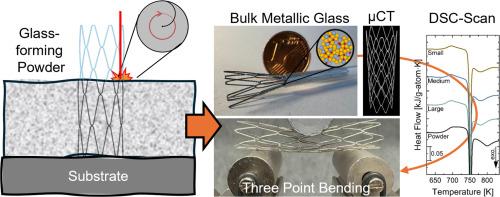Additively manufactured self-expandable stents from Zr-based bulk metallic glasses via laser powder bed fusion
IF 4.7
Q2 ENGINEERING, MANUFACTURING
引用次数: 0
Abstract
Self-expandable stents are among the most implanted biomedical devices. We investigate the feasibility of additive manufacturing via laser powder bed fusion to fabricate Zr-based bulk metallic glasses into self-expandable stents to enable automated and customizable stent fabrication while implementing a novel class of materials with superior resilience compared to established alloys such as Nitinol. Three geometries are investigated with different cell dimensions. The additively manufactured stents are analyzed by µCT, SEM imaging and DSC. Overhanging geometry features show increasing crystalline defects in the amorphous matrix. However, with steep elevation angles, an amorphous fraction of up to 97.3 ± 1% is achieved in the struts. Three-point bending tests reveal large resilience of the structures, allowing for full compaction for diamond shaped cells with a height of 7 mm and an elevation angle of 77.5°, without fracture. Our findings offer preliminary evidence supporting the potential of additive manufacturing for Zr-based bulk metallic glass stents, while further studies are necessary to validate and optimize the process.

以zr基大块金属玻璃为材料,采用激光粉末床熔接技术增材制造自膨胀支架
自膨胀支架是植入最多的生物医学设备之一。我们研究了增材制造的可行性,通过激光粉末床熔融将zr基大块金属玻璃制造成自膨胀支架,以实现自动化和可定制的支架制造,同时实现与镍钛诺等现有合金相比具有优越弹性的新型材料。研究了具有不同单元尺寸的三种几何形状。通过微CT、扫描电镜和DSC对增材制造支架进行分析。悬垂几何特征表明非晶基体中晶体缺陷增多。然而,当仰角较陡时,支板中的非晶态分数可达97.3±1%。三点弯曲试验表明,结构具有很大的弹性,允许高度为7毫米、仰角为77.5°的菱形单元完全压实,而不会断裂。我们的研究结果为支持zr基大块金属玻璃支架的增材制造潜力提供了初步证据,同时需要进一步的研究来验证和优化该工艺。
本文章由计算机程序翻译,如有差异,请以英文原文为准。
求助全文
约1分钟内获得全文
求助全文
来源期刊

Additive manufacturing letters
Materials Science (General), Industrial and Manufacturing Engineering, Mechanics of Materials
CiteScore
3.70
自引率
0.00%
发文量
0
审稿时长
37 days
 求助内容:
求助内容: 应助结果提醒方式:
应助结果提醒方式:


